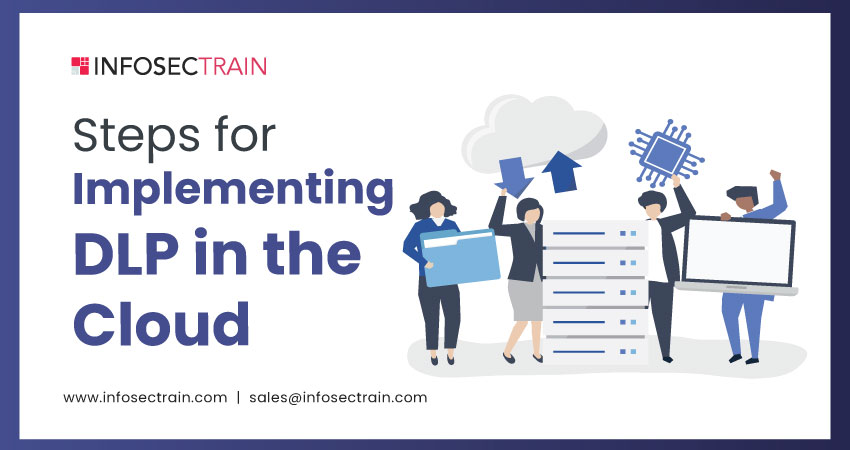Steps for Implementing DLP in the Cloud
Implementing Data Loss Prevention (DLP) measures in the cloud is crucial for safeguarding sensitive information from breaches and unauthorized access. This proactive approach involves deploying security technologies and strategies to prevent data loss or leakage. Implementing DLP in the cloud enables organizations to mitigate risks and meet regulatory standards. Furthermore, DLP safeguards data integrity and confidentiality, fostering trust among customers and stakeholders. With the rising adoption of cloud computing, deploying strong DLP measures becomes crucial in effectively countering evolving cyber threats.

What is Cloud DLP?
Cloud Data Loss Prevention (DLP) involves implementing security measures and technologies to prevent sensitive data from being exposed, accessed, transferred, or leaked in a cloud environment. Its goal is to safeguard data from accidental and intentional threats, ensuring confidentiality, integrity, and availability. DLP solutions typically include data discovery, classification, encryption, access controls, and monitoring to mitigate risks and maintain compliance with regulatory requirements.
Key Steps for Implementing DLP in the Cloud
1. Prioritize Data: It’s essential to prioritize data for cloud data loss prevention, recognizing that not all data holds equal importance. Organizations can allocate resources effectively and implement tailored security measures to protect their most sensitive information by identifying which data would pose the most significant risk if compromised or targeted by attackers.
2. Classify The Data: Data classification involves linking a classification with either the source application or the user responsible for data creation. Sensitive data types like Social Security Numbers or credit card details are commonly recognized as requiring protection. Additionally, predefined rules for specific data categories, such as payment card industry (PCI) and personally identifiable information (PII), aid in efficient classification and protection measures.
3. Recognize the Circumstances where Data is Vulnerable: Files in the cloud become susceptible when they possess wide-ranging sharing permissions, including public, external, or internal across all tenants. Moreover, sensitive files owned by privileged and extensively targeted users are also prone to risk.
4. Observing Data in Transit: Organizations must vigilantly observe data in transit to understand the flow of their sensitive information and potential vulnerabilities, ensuring comprehensive coverage of their cloud-based DLP strategy and prompt resolution of any identified issues.
5. Implementing Precise Data Matching: Utilize precise data matching techniques, which enable the creation of custom identifiers unique to your organization or industry, such as financial services account numbers, local identification forms, or medical record numbers.
6. Establish Communication Channels and Evolve Control Measures: Initially, controls may address universally accepted behaviors among line managers. However, as the cloud DLP program advances, organizations can refine controls to mitigate emerging risks more precisely. Cloud Access Security Brokers (CASBs) facilitate the integration of contextual factors (device, network, user) and content (data classification) to enforce detailed controls.
7. Educate and Guide Employees Consistently: User training is pivotal in mitigating the risk of accidental data breaches by insiders. Employees may occasionally need help understanding how their actions can impact data security, making ongoing education beneficial. CASBs offer the capability to alert users about DLP breaches in the cloud.
8. Rollout: When introducing a new DLP program, initially apply the enhanced security controls to a subset of the most vital data. This approach simplifies the implementation and management of cloud-based DLP. Gradually expand coverage to include additional data with minimal disruption to business operations.
Key Benefits of Using Cloud DLP
- Enhanced Data Security: DLP enhances data security by aiding organizations in minimizing the likelihood of data breaches and unauthorized access to sensitive cloud-stored information. This is accomplished by implementing proactive measures to identify, prevent, and address potential threats, thereby preserving the integrity and confidentiality of vital data assets.
- Enhanced Oversight and Management: DLP furnishes organizations with heightened visibility into data access, utilization, and sharing within the cloud, facilitating more effective control over data security measures. This comprehensive insight empowers organizations to proactively identify and address potential vulnerabilities, ensuring robust protection of sensitive information.
- Enhanced Regulatory Adherence: DLP aids organizations in aligning with diverse industry regulations and data privacy statutes that require safeguarding sensitive data. By implementing robust DLP measures, organizations can demonstrate compliance with regulatory frameworks, minimizing the risk of penalties and reputational damage associated with non-compliance.
- Minimized Human Error Impact: DLP mitigates inadvertent data breaches caused by human errors or insufficient awareness of security protocols. By implementing DLP measures, organizations can reduce the likelihood of data leaks caused by employee mistakes, enhancing their overall data security posture.
Cloud Computing with InfosecTrain
Gain valuable insights from InfosecTrain to understand the importance of recognizing the potential benefits of your cloud investment. When evaluating storage servers or similar advancements, prioritize their impact on end users. Organizations relying on cloud-based data networks require assurance of uninterrupted operations amid server failures, security breaches, or human errors. Explore InfosecTrain’s resources for a deeper understanding of Cloud Computing. Their proficiency will equip you with the experience to enhance your cloud infrastructure and efficiently manage risks.



 1800-843-7890 (India)
1800-843-7890 (India) 
